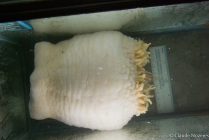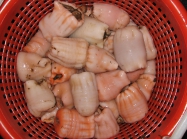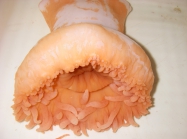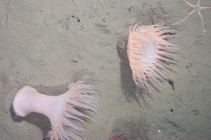ARMS taxon details
Actinostola callosa (Verrill, 1882)
100839 (urn:lsid:marinespecies.org:taxname:100839)
accepted
Species
marine, terrestrial
(of ) Verrill A.E. (1882). Notice of the remarkable marine fauna occupying the outer banks off the southern coast of New England, Nº 4. <i>American Journal of Science</i>, (3)23: 216–225., available online at http://biodiversitylibrary.org/page/38921856
page(s): 224 [details]
page(s): 224 [details]
Rodríguez, E.; Fautin, D; Daly, M. (2025). World List of Actiniaria. Actinostola callosa (Verrill, 1882). Accessed through: Sirenko, B.I.; Clarke, C.; Hopcroft, R.R.; Huettmann, F.; Bluhm, B.A.; Gradinger, R. (eds) (2025) The Arctic Register of Marine Species (ARMS) compiled by the Arctic Ocean Diversity (ArcOD) at: https://www.marinespecies.org/arms/aphia.php?p=taxdetails&id=100839 on 2025-06-02
Sirenko, B.I.; Clarke, C.; Hopcroft, R.R.; Huettmann, F.; Bluhm, B.A.; Gradinger, R. (eds) (2025). The Arctic Register of Marine Species (ARMS) compiled by the Arctic Ocean Diversity (ArcOD). Actinostola callosa (Verrill, 1882). Accessed at: https://www.marinespecies.org/arms/aphia.php?p=taxdetails&id=100839 on 2025-06-02
Date
action
by
original description
(of ) Verrill A.E. (1882). Notice of the remarkable marine fauna occupying the outer banks off the southern coast of New England, Nº 4. <i>American Journal of Science</i>, (3)23: 216–225., available online at http://biodiversitylibrary.org/page/38921856
page(s): 224 [details]
context source (Deepsea) Intergovernmental Oceanographic Commission (IOC) of UNESCO. The Ocean Biogeographic Information System (OBIS), available online at http://www.iobis.org/ [details]
context source (Hexacorallia) Fautin, Daphne G. (2013). Hexacorallians of the World. (look up in IMIS) [details]
basis of record van der Land, J.; den Hartog, J.H. (2001). Actiniaria, <B><I>in</I></B>: Costello, M.J. <i>et al.</i> (Ed.) (2001). <i>European register of marine species: a check-list of the marine species in Europe and a bibliography of guides to their identification. Collection Patrimoines Naturels,</i> 50: pp. 106-109 (look up in IMIS) [details]
additional source Gosner, K. L. (1971). Guide to identification of marine and estuarine invertebrates: Cape Hatteras to the Bay of Fundy. <em>John Wiley & Sons, Inc., London.</em> 693 pp. [pdf copepod and branchiuran :445-455]. (look up in IMIS) [details] Available for editors
additional source Linkletter, L. E. (1977). A checklist of marine fauna and flora of the Bay of Fundy. <em>Huntsman Marine Laboratory, St. Andrews, N.B.</em> 68: p. [details]
additional source Sebens, K.P. 1998. Marine flora and fauna of the eastern United States. Anthozoa, Actinaria, Corallimorparia, Ceriantharia, and Zoanthidea. NOAA Technical Report NMFS 141. 68 p. (look up in IMIS) [details]
additional source Doumenc D. & Van-praet M. (1988). Deep-sea anemones from a hydrothermal vent area in the East Pacific. Oceanologica Acta. Volume spécial, 8, 61-68.
page(s): 63 [details]
additional source Whiteaves J.F. (1901). Catalogue of the marine Invertebrata of eastern Canada. Geological Survey of Canada, 722, pp. 1-272., available online at https://www.biodiversitylibrary.org/page/12912999
page(s): 40 [details]
additional source Grieg, J.A., 1913. Bidrag til kundskapen om Hardangerfjordens fauna. Bergens Mus. Arb. 1913 1: 1-147.
page(s): 144 [details]
additional source Verrill, A. E. (1885). Results of the explorations made by the Steamer Albatross off the northern coast of the United States, in 1883. <em>Annual Report of the United States Commission of Fish and Fisheries, Washington.</em> 11, 503-699, plates 1-43 (begin p.604)., available online at https://www.biodiversitylibrary.org/page/30854749
page(s): 515, 534 [details]
additional source Carlgren, O. (1921). Actiniaria I. <em>Danish Ingolf-Expedition.</em> 5(9):1-241, figs. 1-210, pls. 1-4., available online at https://www.biodiversitylibrary.org/page/19695128
page(s): 227-229 [details]
additional source Gravier, C. (1918). Note preliminaire sur les Hexactiniaires recueillis au cours des croisieres de la Princesse-Alice et de l'Hirondelle de 1888 a 1913 inclusivement. <i>Bull. Inst. Oceanogr., Monaco</i>. 346:1-24.
page(s): 2 [details]
additional source Daly, M. & Gusmão, L. (2007). The first sea anemone (Cnidaria: Anthozoa: Actiniaria) from a whale fall. <em>Journal of Natural History.</em> 41(1-4): 1-11., available online at https://doi.org/10.1080/00222930601121775
page(s): 8 [details]
additional source López-González, P. J.; Rodríguez, E. & Segonzac, M. (2005). A new species of sea anemone (Cnidaria: Anthozoa: Actiniaria) from Manus Basin hydrothermal vents, South-western Pacific Published in collaboration with the University of Bergen and the Institute of Marine Research, Norway, and the Marine Biological Laboratory, University of Copenhagen, Denmark. <em>Marine Biology Research.</em> 1(5): 326-337., available online at https://doi.org/10.1080/17451000500380306
page(s): 326 [details]
additional source Sanamyan, N.P. & Sanamyan, K.E. (2007). Deep-water Actiniaria from East Pacific hydrothermal vents and cold seep. <em>Invertebrate Zoology.</em> 4(1): 83-102.
page(s): 101 [details] Available for editors
additional source Rees, O. M. (1913). XLV.—Notes on Actinostola callosa (Verrill) = Dysactis crassicornis (Hertwig). <em>Journal of Natural History Series 8.</em> 12(70): 382-387., available online at https://doi.org/10.1080/00222931308693413
page(s): 382-387 [details]
additional source Carlgren, O. (1893). Studien über Nordische Actinien. <em>K. Svenska Vet.-Akad. Handl., Bd. XXV, No. 10. Stockholm.</em>
page(s): 71-76, 148, Pl. I figs. 17, 19 [details]
additional source Carlgren, O. (1949). A survey of the Ptychodactiaria, Corallimorpharia and Actiniaria. <em>Kungliga Svenska Vet- enskapsakadamiens Handlingar.</em> 1: 1–121.
page(s): 78 [details]
additional source Stephenson, T. A. (1920). On the classification of Actiniaria. Part I. -- Forms with acontia and forms with a mesogloeal sphincter. <em>Quarterly Journal of Microscopical Science.</em> 64, 2, (256): 425-574., available online at https://www.biodiversitylibrary.org/page/27706883#page/509/mode/1up
page(s): 557 [details]
additional source Fautin, D. G.; Barber, B. R. (1999). Maractis rimicarivora, a new genus and species of sea anemone (Cnidaria: Anthozoa: Actiniaria: Actinostolidae) from an Atlantic hydrothermal vent. <em>Proceedings of the Biological Society of Washington.</em> 112(3): 624-631.
page(s): 624 [details]
additional source Verrill, A.E. (1883). Report on the Anthozoa, and on some additional species dredged by the "Blake" in 1877-1879, and by the U.S. Fish Commission steamer "Fish Hawk" in 1880-82. <em>Bull. Mus. Comp. Zool. Harvard.</em> 11: 1-72, plates 1-8., available online at https://www.biodiversitylibrary.org/page/4621758
page(s): 57-58 [details]
additional source Nordgaard, O. (1905). Hydrographical and Biological Investigations in Norwegian Fiords. Bergens Museums Meereskrifter, 2: 164-174, 243
page(s): 159 [details]
additional source Parker, G. H. (1900). Synopses of North-American invertebrates. XIII. The Actiniaria. American Naturalist, 34, 747-758
page(s): 753 [details]
additional source Riemann-Zürneck, K. (1978). Actiniaria des Südwestatlantik IV. Actinostola crassicornis (Hertwig, 1882) mit einer Diskussion verwandter Arten. Veröffentlichungen des Institutes für Meeresforschung Bremerhaven, 17, 65-85
page(s): 66, 75-80, 82 [details]
additional source Sebens, K. P. (1998). Anthozoa: Actiniaria, Zoanthidea, Corallimorpharia, and Ceriantharia. National Marine Fisheries Service. Seattle., volume 141, pp. 1-67
page(s): 11, 15, 40, 52 [details]
additional source Widersten, B. (1976). Ceriantharia, Zoanthidea, Corallimorpharia, and Actiniaria from the continental shelf and slope off the eastern coast of the United States. Fishery Bulletin, 74(4): 857-878
page(s): 865-868 [details]
additional source Carlgren, O. (1940). A contribution to the knowledge of the structure and distribution of the cnidae in the Anthozoa. Kungliga Fysiografiska Sällskapets Handlingar, 51, N.F., (3): 1-62
page(s): 7, 36, 37 [details]
additional source Carlgren, O. (1933). The Godthaab Expedition 1928 Zoantharia and Actiniaria. Meddelelser om Grønland, 79(8): 1-55
page(s): 14-15 [details]
additional source Kwietniewski, C. R. (1898). Actiniaria von Ost-Spitzbergen, nach den Sammlungen von Prof. Dr. W. Kükenthal und Dr. A. Walter. Zoologische Jahrbücher Abteilung für Systematik, Geographie und Biologie der Tiere, 11, 121-140
page(s): 122 [details]
additional source Fautin, D. G. (1984). More Antarctic and Subantarctic sea anemones (Coelenterata: Corallimorpharia and Actiniaria). Antarctic Research Series, 41, 1-42
page(s): 18, 23 [details]
additional source Gravier, C. (1922). Hexactinidés provenant des campagnes des yachts Hirondelle I et II et Princesse-Alice I et II (1888-1913). Imprimerie de Monaco. Monaco., volume 63, pp. 104
page(s): 9-10, 29-30, 94-95, Pl. II, figs. 12-13 [details]
additional source Grebelny, S. D. (1980). Distribution of the Actiniae in the Arctic. Zoological Institute of the Academy of Sciences of the USSR. Leningrad and Murmamsk., pp. 20-33
page(s): 20, 23-24, 26 [details]
additional source McMurrich, J. P. (1893). Report on the Actiniæ collected by the United States Fish Commission Steamer Albatross during the winter of 1887-1888. Proceedings of the United States National Museum, 16(930): 119-216
page(s): 167-170, 172, 196, 205-207, 209 [details]
additional source McMurrich, J. P. (1904). The Actiniae of the Plate collection. Zoologische Jahrbücher, 6 Suppl.(2): 215-306
page(s): 249 [details]
additional source Riemann-Zürneck, K. (1971). Die Variabilität taxonomisch wichtiger Merkmale bei Actinostola callosa (Anthozoa: Actiniaria). Veröffentlichungen des Institutes für Meeresforschung Bremerhaven, 13, 153-162
page(s): 153-162 [details]
additional source Kostina, E. E. (1988). Biogeographical characteristics of sea anemones of the Pacific boreal region. Biologiya Morya, 1988(3): 14-21
page(s): 18 [details]
additional source Grebelny, S. D. (1982). Symmetriya aktinei i ee znachenie dlya klassifikatsii Anthozoa [Symmetry of actinians and its significance for the classification of Anthozoa]. Akademiya Nauk SSSR [Academy of Sciences of the USSR]. Vladivostok., pp. 101-123
page(s): 103, 104 [details]
additional source Uchida, H.; Soyama, I. (2001). Sea Anemones in Japanese Waters. TBS. Japan., pp. 157.
page(s): 48, 150, 154 [details]
additional source Carlgren, O. (1945). Polypdyr (Coelenterata) III. Koraldyr. Danmarks Fauna Udgivet af Dansk Naturhistorisk Forening, 51, 3-167
page(s): 124, 157 [details]
additional source Zhiubikas, I. I. (1977). Some species of actinians of the western region of the Barents Sea and Franz Josef Land. Academy of Sciences of the U.S.S.R. Zoological Institute. St. Petersburg., volume Explorations of the fauna of the seas XIV (XXII), pp. 106-125
page(s): 112-114 [details]
additional source Jonsson, L. G.; Nilsson, P. G.; Floruta, F.; Lundälv, T. (2004). Distributional patterns of macro- and megafauna associated with a reef of the cold-water coral Lophelia pertusa on the Swedish west coast. Marine Ecology Progress Series, 284, 163-171
page(s): 166 [details]
additional source Klyshko, E. V.; Ilyna, A. P.; Monastyrnaya, M. M.; Burtseva, Y. V.; Kostina, E. E.; Zykova, T. A.; Menzorova, N. I.; Kozlovskaya, E. P. (2003). Biologically active polypeptides and hydrolytic enzymes in sea anemones of northern temperate waters. Russian Journal of Marine Biology, 29(3): 161-166
page(s): 162-164 [details]
additional source Mortensen, P. B.; Hovland, M.; Brattegard, T.; Farestveit, R. (1995). Deep water bioherms of the scleractinian coral Lophelia pertusa (L.) at 64° N on the Norwegian shelf: structure and associated megafauna. Sarsia, 80, 145-158
page(s): 150, 151, 157 [details]
additional source Grebelny, S. D. (1986). Class Anthozoa, subclass Hexacorallia -- hexameral corals, orders Actiniaria and Ptychodactiaria [in Russian]. Akademia Nauk, USSR. Apatity, pp. 87-91
page(s): 88, 90 [details]
additional source Grebel'nyi, S. D. (2001). Hexacorallia. Explorations of the Fauna of the Seas, 51(59): 36-38
page(s): 37 [details]
additional source Zamponi, M. O. (1984). Los primeros estadios del desarrollo en Actinostola crassicornis (Hertwig, 1882) (Actiniaria: Actinostolidae). Neotropica, 30, 83, 111-120
page(s): 116, 117 [details]
additional source Carlgren, O. (1928). Ceriantharier, Zoantharier och Actiniarier. Meddelelser om Grønland, 23 Suppl., 253-308
page(s): 256, 257, 260, 284-285 [details]
additional source Integrated Taxonomic Information System (ITIS). , available online at http://www.itis.gov [details]
additional source Fautin, Daphne G. (2013). Hexacorallians of the World. (look up in IMIS) [details]
page(s): 224 [details]
context source (Deepsea) Intergovernmental Oceanographic Commission (IOC) of UNESCO. The Ocean Biogeographic Information System (OBIS), available online at http://www.iobis.org/ [details]
context source (Hexacorallia) Fautin, Daphne G. (2013). Hexacorallians of the World. (look up in IMIS) [details]
basis of record van der Land, J.; den Hartog, J.H. (2001). Actiniaria, <B><I>in</I></B>: Costello, M.J. <i>et al.</i> (Ed.) (2001). <i>European register of marine species: a check-list of the marine species in Europe and a bibliography of guides to their identification. Collection Patrimoines Naturels,</i> 50: pp. 106-109 (look up in IMIS) [details]
additional source Gosner, K. L. (1971). Guide to identification of marine and estuarine invertebrates: Cape Hatteras to the Bay of Fundy. <em>John Wiley & Sons, Inc., London.</em> 693 pp. [pdf copepod and branchiuran :445-455]. (look up in IMIS) [details] Available for editors
additional source Linkletter, L. E. (1977). A checklist of marine fauna and flora of the Bay of Fundy. <em>Huntsman Marine Laboratory, St. Andrews, N.B.</em> 68: p. [details]
additional source Sebens, K.P. 1998. Marine flora and fauna of the eastern United States. Anthozoa, Actinaria, Corallimorparia, Ceriantharia, and Zoanthidea. NOAA Technical Report NMFS 141. 68 p. (look up in IMIS) [details]
additional source Doumenc D. & Van-praet M. (1988). Deep-sea anemones from a hydrothermal vent area in the East Pacific. Oceanologica Acta. Volume spécial, 8, 61-68.
page(s): 63 [details]
additional source Whiteaves J.F. (1901). Catalogue of the marine Invertebrata of eastern Canada. Geological Survey of Canada, 722, pp. 1-272., available online at https://www.biodiversitylibrary.org/page/12912999
page(s): 40 [details]
additional source Grieg, J.A., 1913. Bidrag til kundskapen om Hardangerfjordens fauna. Bergens Mus. Arb. 1913 1: 1-147.
page(s): 144 [details]
additional source Verrill, A. E. (1885). Results of the explorations made by the Steamer Albatross off the northern coast of the United States, in 1883. <em>Annual Report of the United States Commission of Fish and Fisheries, Washington.</em> 11, 503-699, plates 1-43 (begin p.604)., available online at https://www.biodiversitylibrary.org/page/30854749
page(s): 515, 534 [details]
additional source Carlgren, O. (1921). Actiniaria I. <em>Danish Ingolf-Expedition.</em> 5(9):1-241, figs. 1-210, pls. 1-4., available online at https://www.biodiversitylibrary.org/page/19695128
page(s): 227-229 [details]
additional source Gravier, C. (1918). Note preliminaire sur les Hexactiniaires recueillis au cours des croisieres de la Princesse-Alice et de l'Hirondelle de 1888 a 1913 inclusivement. <i>Bull. Inst. Oceanogr., Monaco</i>. 346:1-24.
page(s): 2 [details]
additional source Daly, M. & Gusmão, L. (2007). The first sea anemone (Cnidaria: Anthozoa: Actiniaria) from a whale fall. <em>Journal of Natural History.</em> 41(1-4): 1-11., available online at https://doi.org/10.1080/00222930601121775
page(s): 8 [details]
additional source López-González, P. J.; Rodríguez, E. & Segonzac, M. (2005). A new species of sea anemone (Cnidaria: Anthozoa: Actiniaria) from Manus Basin hydrothermal vents, South-western Pacific Published in collaboration with the University of Bergen and the Institute of Marine Research, Norway, and the Marine Biological Laboratory, University of Copenhagen, Denmark. <em>Marine Biology Research.</em> 1(5): 326-337., available online at https://doi.org/10.1080/17451000500380306
page(s): 326 [details]
additional source Sanamyan, N.P. & Sanamyan, K.E. (2007). Deep-water Actiniaria from East Pacific hydrothermal vents and cold seep. <em>Invertebrate Zoology.</em> 4(1): 83-102.
page(s): 101 [details] Available for editors
additional source Rees, O. M. (1913). XLV.—Notes on Actinostola callosa (Verrill) = Dysactis crassicornis (Hertwig). <em>Journal of Natural History Series 8.</em> 12(70): 382-387., available online at https://doi.org/10.1080/00222931308693413
page(s): 382-387 [details]
additional source Carlgren, O. (1893). Studien über Nordische Actinien. <em>K. Svenska Vet.-Akad. Handl., Bd. XXV, No. 10. Stockholm.</em>
page(s): 71-76, 148, Pl. I figs. 17, 19 [details]
additional source Carlgren, O. (1949). A survey of the Ptychodactiaria, Corallimorpharia and Actiniaria. <em>Kungliga Svenska Vet- enskapsakadamiens Handlingar.</em> 1: 1–121.
page(s): 78 [details]
additional source Stephenson, T. A. (1920). On the classification of Actiniaria. Part I. -- Forms with acontia and forms with a mesogloeal sphincter. <em>Quarterly Journal of Microscopical Science.</em> 64, 2, (256): 425-574., available online at https://www.biodiversitylibrary.org/page/27706883#page/509/mode/1up
page(s): 557 [details]
additional source Fautin, D. G.; Barber, B. R. (1999). Maractis rimicarivora, a new genus and species of sea anemone (Cnidaria: Anthozoa: Actiniaria: Actinostolidae) from an Atlantic hydrothermal vent. <em>Proceedings of the Biological Society of Washington.</em> 112(3): 624-631.
page(s): 624 [details]
additional source Verrill, A.E. (1883). Report on the Anthozoa, and on some additional species dredged by the "Blake" in 1877-1879, and by the U.S. Fish Commission steamer "Fish Hawk" in 1880-82. <em>Bull. Mus. Comp. Zool. Harvard.</em> 11: 1-72, plates 1-8., available online at https://www.biodiversitylibrary.org/page/4621758
page(s): 57-58 [details]
additional source Nordgaard, O. (1905). Hydrographical and Biological Investigations in Norwegian Fiords. Bergens Museums Meereskrifter, 2: 164-174, 243
page(s): 159 [details]
additional source Parker, G. H. (1900). Synopses of North-American invertebrates. XIII. The Actiniaria. American Naturalist, 34, 747-758
page(s): 753 [details]
additional source Riemann-Zürneck, K. (1978). Actiniaria des Südwestatlantik IV. Actinostola crassicornis (Hertwig, 1882) mit einer Diskussion verwandter Arten. Veröffentlichungen des Institutes für Meeresforschung Bremerhaven, 17, 65-85
page(s): 66, 75-80, 82 [details]
additional source Sebens, K. P. (1998). Anthozoa: Actiniaria, Zoanthidea, Corallimorpharia, and Ceriantharia. National Marine Fisheries Service. Seattle., volume 141, pp. 1-67
page(s): 11, 15, 40, 52 [details]
additional source Widersten, B. (1976). Ceriantharia, Zoanthidea, Corallimorpharia, and Actiniaria from the continental shelf and slope off the eastern coast of the United States. Fishery Bulletin, 74(4): 857-878
page(s): 865-868 [details]
additional source Carlgren, O. (1940). A contribution to the knowledge of the structure and distribution of the cnidae in the Anthozoa. Kungliga Fysiografiska Sällskapets Handlingar, 51, N.F., (3): 1-62
page(s): 7, 36, 37 [details]
additional source Carlgren, O. (1933). The Godthaab Expedition 1928 Zoantharia and Actiniaria. Meddelelser om Grønland, 79(8): 1-55
page(s): 14-15 [details]
additional source Kwietniewski, C. R. (1898). Actiniaria von Ost-Spitzbergen, nach den Sammlungen von Prof. Dr. W. Kükenthal und Dr. A. Walter. Zoologische Jahrbücher Abteilung für Systematik, Geographie und Biologie der Tiere, 11, 121-140
page(s): 122 [details]
additional source Fautin, D. G. (1984). More Antarctic and Subantarctic sea anemones (Coelenterata: Corallimorpharia and Actiniaria). Antarctic Research Series, 41, 1-42
page(s): 18, 23 [details]
additional source Gravier, C. (1922). Hexactinidés provenant des campagnes des yachts Hirondelle I et II et Princesse-Alice I et II (1888-1913). Imprimerie de Monaco. Monaco., volume 63, pp. 104
page(s): 9-10, 29-30, 94-95, Pl. II, figs. 12-13 [details]
additional source Grebelny, S. D. (1980). Distribution of the Actiniae in the Arctic. Zoological Institute of the Academy of Sciences of the USSR. Leningrad and Murmamsk., pp. 20-33
page(s): 20, 23-24, 26 [details]
additional source McMurrich, J. P. (1893). Report on the Actiniæ collected by the United States Fish Commission Steamer Albatross during the winter of 1887-1888. Proceedings of the United States National Museum, 16(930): 119-216
page(s): 167-170, 172, 196, 205-207, 209 [details]
additional source McMurrich, J. P. (1904). The Actiniae of the Plate collection. Zoologische Jahrbücher, 6 Suppl.(2): 215-306
page(s): 249 [details]
additional source Riemann-Zürneck, K. (1971). Die Variabilität taxonomisch wichtiger Merkmale bei Actinostola callosa (Anthozoa: Actiniaria). Veröffentlichungen des Institutes für Meeresforschung Bremerhaven, 13, 153-162
page(s): 153-162 [details]
additional source Kostina, E. E. (1988). Biogeographical characteristics of sea anemones of the Pacific boreal region. Biologiya Morya, 1988(3): 14-21
page(s): 18 [details]
additional source Grebelny, S. D. (1982). Symmetriya aktinei i ee znachenie dlya klassifikatsii Anthozoa [Symmetry of actinians and its significance for the classification of Anthozoa]. Akademiya Nauk SSSR [Academy of Sciences of the USSR]. Vladivostok., pp. 101-123
page(s): 103, 104 [details]
additional source Uchida, H.; Soyama, I. (2001). Sea Anemones in Japanese Waters. TBS. Japan., pp. 157.
page(s): 48, 150, 154 [details]
additional source Carlgren, O. (1945). Polypdyr (Coelenterata) III. Koraldyr. Danmarks Fauna Udgivet af Dansk Naturhistorisk Forening, 51, 3-167
page(s): 124, 157 [details]
additional source Zhiubikas, I. I. (1977). Some species of actinians of the western region of the Barents Sea and Franz Josef Land. Academy of Sciences of the U.S.S.R. Zoological Institute. St. Petersburg., volume Explorations of the fauna of the seas XIV (XXII), pp. 106-125
page(s): 112-114 [details]
additional source Jonsson, L. G.; Nilsson, P. G.; Floruta, F.; Lundälv, T. (2004). Distributional patterns of macro- and megafauna associated with a reef of the cold-water coral Lophelia pertusa on the Swedish west coast. Marine Ecology Progress Series, 284, 163-171
page(s): 166 [details]
additional source Klyshko, E. V.; Ilyna, A. P.; Monastyrnaya, M. M.; Burtseva, Y. V.; Kostina, E. E.; Zykova, T. A.; Menzorova, N. I.; Kozlovskaya, E. P. (2003). Biologically active polypeptides and hydrolytic enzymes in sea anemones of northern temperate waters. Russian Journal of Marine Biology, 29(3): 161-166
page(s): 162-164 [details]
additional source Mortensen, P. B.; Hovland, M.; Brattegard, T.; Farestveit, R. (1995). Deep water bioherms of the scleractinian coral Lophelia pertusa (L.) at 64° N on the Norwegian shelf: structure and associated megafauna. Sarsia, 80, 145-158
page(s): 150, 151, 157 [details]
additional source Grebelny, S. D. (1986). Class Anthozoa, subclass Hexacorallia -- hexameral corals, orders Actiniaria and Ptychodactiaria [in Russian]. Akademia Nauk, USSR. Apatity, pp. 87-91
page(s): 88, 90 [details]
additional source Grebel'nyi, S. D. (2001). Hexacorallia. Explorations of the Fauna of the Seas, 51(59): 36-38
page(s): 37 [details]
additional source Zamponi, M. O. (1984). Los primeros estadios del desarrollo en Actinostola crassicornis (Hertwig, 1882) (Actiniaria: Actinostolidae). Neotropica, 30, 83, 111-120
page(s): 116, 117 [details]
additional source Carlgren, O. (1928). Ceriantharier, Zoantharier och Actiniarier. Meddelelser om Grønland, 23 Suppl., 253-308
page(s): 256, 257, 260, 284-285 [details]
additional source Integrated Taxonomic Information System (ITIS). , available online at http://www.itis.gov [details]
additional source Fautin, Daphne G. (2013). Hexacorallians of the World. (look up in IMIS) [details]
 Present
Present  Inaccurate
Inaccurate  Introduced: alien
Introduced: alien  Containing type locality
Containing type locality












